SASKATOON — As wildfires continue to pose a threat in northern Saskatchewan, Premier Scott Moe recently addressed the crisis, emphasizing both immediate response efforts and long-term strategies to improve prevention and preparedness across the province.
The Saskatchewan Public Safety Agency (SPSA) implements the province’s Wildfire Prevention and Preparedness Plan and co-ordinates the efforts of firefighters, volunteers, Indigenous leaders and other first responders as wildfires spread through northern communities.
Moe, speaking at a press briefing on Wednesday at the Saskatchewan Cabinet Office, first thanked everyone who has been on the front lines of the wildfires that displaced more than 17,000 northern Saskatchewan residents.
“We’ve seen extraordinary efforts from Saskatchewan’s responders, our municipal fire departments, and even firefighting crews from across Canada and the United States. They’ve worked tirelessly to save homes, cabins and entire communities,” said Moe.
He added that, since wildfires occur every year, the existing plan is constantly being updated and refined over the years. One of the examples of preventative measures is the FireSmart program, which aims to educate on what can be done to prevent and prepare for wildfires.
The FireSmart program focuses on reducing human-caused fires, particularly during high-risk periods such as spring and summer. It encourages responsible recreational activities, such as the use of ATVs and open burning.
“We’re seeing more people exploring the North, and that’s great, but we’re also asking everyone to be fire smart in their activities, because the consequences can be devastating. … This year has been tremendously challenging, but we are committed to strengthening Saskatchewan’s preparedness, supporting our families, and learning everything we can to protect communities better going forward. We will always evaluate our performance in the aftermath of significant events like this. We’ve heard from evacuees and community leaders that support needs to be more prompt and better tailored. Those are lessons we’ll take seriously,” said Moe.
He added that the province will continue to train Indigenous Type 2 firefighters through partnerships with Indigenous leaders. Type 2 firefighters are trained in hand, engine and helitack fire suppression.
“Rather than always relying on the military or Type 3 firefighters, we’ve trained over 400 additional Type 2 firefighters from northern Indigenous communities in recent years. They’re already proving critical in our response,” said Moe.
Moe also announced a multi-year investment in modernizing the province’s aerial firefighting fleet, including the purchase of new air tankers and upgrades to older equipment to increase water-carrying capacity and improve overall response time.
“These investments are significant and ongoing, ensuring we have the largest degree of firefighting readiness possible. We saw that need just weeks ago,” said Moe, as the province experienced less rainfall this season.
He reminded the public to be cautious during the spring and summer months, as the consequences of their activities — such as riding an ATV — can be severe. He was also thankful that there were no reported fatalities during the wildfires.




